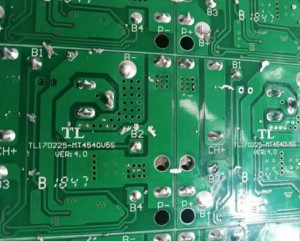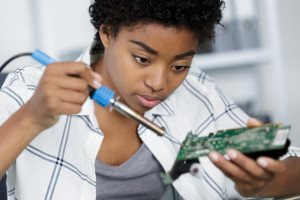You can burn your fingers on freshly roasted chestnuts in winter temperatures. It's no different in electronic manufacturing.
 Nowonder the monkey in the fable told the cat to make the risky maneuver of getting the chestnuts out of the fire [1], even though these predators are more likely to massacre and eat mice, birds and lizards. Although chestnuts are rarely roasted in electronic production, they do have to deal with high temperatures. This is because the melting of the alloy alone is required if the two joining elements are to be connected in an electrically conductive manner. These are then components and circuit board or wire and socket.
Nowonder the monkey in the fable told the cat to make the risky maneuver of getting the chestnuts out of the fire [1], even though these predators are more likely to massacre and eat mice, birds and lizards. Although chestnuts are rarely roasted in electronic production, they do have to deal with high temperatures. This is because the melting of the alloy alone is required if the two joining elements are to be connected in an electrically conductive manner. These are then components and circuit board or wire and socket.
The fact that heat is not always handled with care can be seen in many repair departments, where the soldering irons are set to full power. The hotter the faster - but unfortunately not the better, as this results in a lot of damage and loss of quality.
When reflow soldering PCBs, ovens are used - usually convection types - and the product engineer would certainly like to know what happens in her oven.
This is referred to as thermal profiles and it depends on whether they are only created for regular process monitoring or whether a new one is to be set up in the machine. Since the days of lead-free solder, it has rarely been possible to manufacture related products with the same temperature application.
In this case, some theoretical and technical questions need to be answered. You need to know the circuit board with the components well and also the properties of the chemicals in the paste. The latter have become far more critical in the meantime, because the dear industrial chemists have not yet succeeded in finding acids in their reference books that are (largely) harmless to the environment and health and that work well for the temperatures currently being used. After all, they should not starve before reaching the melting temperature and then do their job during wetting. It is also desirable that they evaporate quickly afterwards or at least disintegrate into largely harmless residues on the assembly.
The pillow defect is feared
 The shrewd engineer expects perfect results for her printed circuit boardThemaximum temperature and speed of heating (delta T or gradient) are equally important for the printed circuit board and the components, as bending and discarding as well as component failure are affected. The dreaded pillow defect occurs when the connection between the paste and the component ball is lost at the wrong moment.
The shrewd engineer expects perfect results for her printed circuit boardThemaximum temperature and speed of heating (delta T or gradient) are equally important for the printed circuit board and the components, as bending and discarding as well as component failure are affected. The dreaded pillow defect occurs when the connection between the paste and the component ball is lost at the wrong moment.
Most manufacturers specify the maximum temperatures and dwell times that should not be exceeded for their temperature-sensitive components, although they usually conceal the 'why'.
With reflow systems, operators often overlook the fact that their temperature behavior changes constantly during start-up and operation. In order to maintain a stable internal environment, not only must the heating period be fully run, but the influence of production must also be taken into account, because every assembly that runs into the machine draws energy from it and thus influences the temperature profile.
In order to obtain comprehensible values, the machine must therefore run in normal operation. This means, for example, that the distance between the assemblies is kept as constant as possible, which has to do with the control devices that overcompensate in the event of a drop in temperature.
For the same reason, the measuring device is moved into the system at a suitable distance after the assembly. This avoids potential and undesirable errors in the measurements, as the thermal properties of the instrument may also influence the internal temperature. Finally, it is packed in an insulation box so that the solder joints inside do not melt.
Although it is also possible to record the profile with a tachograph, nowadays most companies use special devices, partly out of convenience, partly due to marketing - but of course also because of the possibilities of such devices, as they allow several thermocouples to be used simultaneously for measurement. This means that critical points on the assembly (e.g. top and bottom) can be measured in a single pass.
Manufacturers and distributors of such instruments naturally offer courses which, in addition to advertising, often also provide important instructions, such as not pulling the wires tightly, but rather looping them so that a sudden voltage in the oven does not cause the sensor to lift off.
These instruments are designed for special thermocouples, which should not be overlooked. This, by the way, is a separate topic and the process engineer should not only be aware of the different wire combinations but also understand how and when and how fast they measure.
The 'golden assembly' does not last forever
 Kapton adhesive tape makes it possible to attach thermocouples that can be removed later without leaving any residueThenext problem is how to attach them, as there are several alternatives. Usually a 'golden assembly' is prepared, which is then used more often. However, it should be clear that after a few runs (ten? Twenty?) through the system, such assemblies no longer provide usable and reliable measurements and a new one is needed for use. The old one is scrap, or rather 'hazardous waste'.
Kapton adhesive tape makes it possible to attach thermocouples that can be removed later without leaving any residueThenext problem is how to attach them, as there are several alternatives. Usually a 'golden assembly' is prepared, which is then used more often. However, it should be clear that after a few runs (ten? Twenty?) through the system, such assemblies no longer provide usable and reliable measurements and a new one is needed for use. The old one is scrap, or rather 'hazardous waste'.
If the assembly is to be sold after the measurement, the thermocouples must be attached in such a way that they can be removed without leaving any residue. Kapton adhesive tape may then be an option. However, some measurements will then be missed, such as under large components.
Nowadays, modern systems offer the option of saving the process data directly. This allows the desired profiles to be called up at the touch of a button when a new assembly is to be manufactured.
However, the clever process engineer has already set up her own data collection on her laptop. This not only shows the data created and a pretty picture of the profile achieved, but also the assembly with and without the thermal sensor. In addition, there is information about the circuit board, the components at risk and the measures and considerations in the choice and shape of the profile. Details about the paste used and the print template are also stored.
Such data collections are not only important from an information point of view, but a lot can be learned about the process and the system through comparisons with other profile data and calculations.
Clever and well-informed as our engineer above is, she took the precaution of saving everything on several UBS storage devices. You never know if Murphy [2] will be right again and strike mercilessly.
Literature
22 Simple Tips for Running Successful Thermal Profiles, ECD, 2022(www.ecd.com)
Attaching Thermocouples to a PCB for Reflow Profling, Indium Corporation(www.indium.com)
Ed Briggs; Ronald C. Lasky: Best Practices Reflow Profling for Lead-Free SMT Assembly
Other references
www.kapton-klebeband.de
www.leadsintec.com
References
[1] The saying goes back to an oriental fable. In it, a (clever) monkey persuades a (less clever) cat to fetch roasted chestnuts from the fire for him. In La Fontaine (1621-1695), this theme appears in Fable IX, 15
[2] Murphy's law is attributed to the American engineer Edward A. Murphy Jr: "Anything that can go wrong will go wrong." ("Anything that can go wrong will go wrong.") - It probably goes back to John W. Campbell Jr. (1910-1971)


